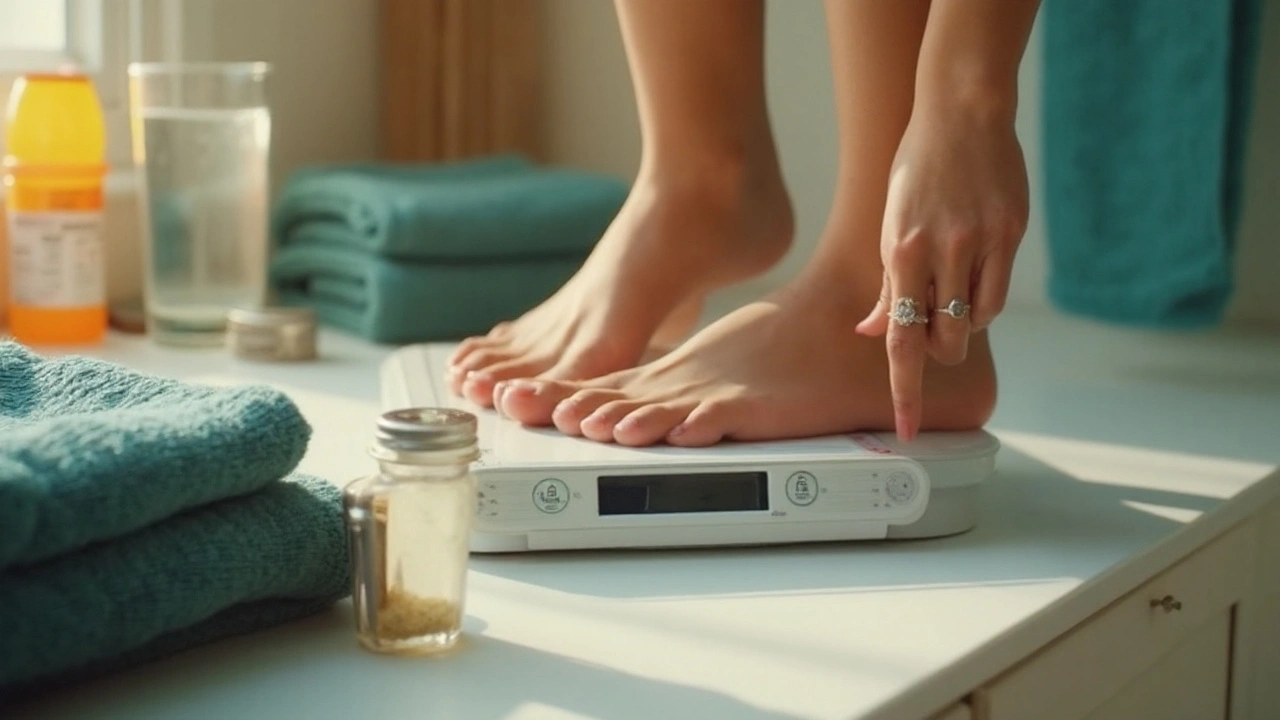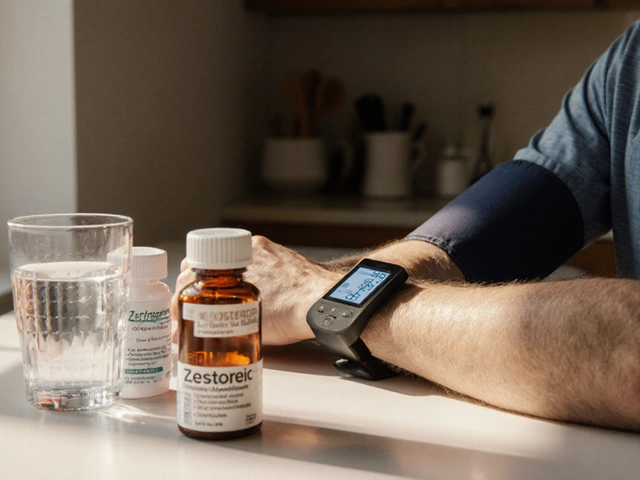Noticing the scale creep after starting midodrine? You’re not the first to wonder if the pill that helps your blood pressure is quietly adding pounds. Here’s the straight answer: weight gain isn’t a classic midodrine side effect, but your routine around treating orthostatic symptoms can change your weight. This guide shows the evidence, helps you tell water from fat, and gives you practical steps to keep things steady without losing symptom control.
TL;DR - Key takeaways
- Clinical trials and drug labels don’t list weight gain as a common midodrine side effect. If your weight is up, look first at salt/fluid strategies, reduced activity, or other meds like fludrocortisone.
- Quick weight jumps (for example, 1-2 kg over a few days) usually point to water retention, not fat. Fat gain takes weeks.
- Rule of thumb: 1 kg ≈ 1 litre of retained fluid. Swelling in ankles/hands, tighter rings, and puffier mornings are telltale signs.
- Don’t stop midodrine abruptly. Track daily weights, review salt targets, and speak to your prescriber about dosing, timing, and companion meds if weight rises fast.
- Red flags to seek urgent care: rapid weight gain with shortness of breath, chest discomfort, severe supine hypertension, or new swelling up to the knees.

What the evidence says, why weight can change, and how to take control
What most people want to know first is whether the medicine itself is to blame. Midodrine is a peripherally acting alpha-1 agonist used for orthostatic hypotension (and sometimes POTS under specialist care). Its job is to tighten blood vessels when you’re upright. The common side effects on the official sheets are piloerection (goosebumps), scalp tingling, urinary urgency/retention, and supine hypertension. Weight gain doesn’t make the usual lists in the FDA label for ProAmatine or the UK Summary of Product Characteristics. That’s the starting point.
So why do some people report weight gain after starting it? Three patterns come up again and again:
- Salt and fluid loading: If you’ve been told to increase salt to manage symptoms (often 6-10 g of sodium chloride per day, sometimes more under specialist advice) and to drink 2-3 litres, you will carry more water. That’s the point. The trade-off is the scale moves up. It’s not fat, it’s volume.
- Fludrocortisone or other meds: Many patients are on fludrocortisone as well, which actively retains sodium and water. That drug is a frequent driver of swelling and weight gain. Beta-blockers, often used in POTS, can also nudge weight up by lowering heart rate and potentially activity level for some.
- Reduced activity: When standing makes you dizzy, you move less. Less movement can lead to deconditioning, fewer calories burned, and-over weeks-actual fat gain.
Does midodrine itself make you retain fluid? Not directly. It can cause urinary retention in some, which might mask how much you’re actually passing. But there isn’t a strong signal that midodrine triggers fluid accumulation the way fludrocortisone does. Still, indirect effects matter, especially if you’ve upped salt and fluids.
What does the research say? Trials that got midodrine approved focused on blood pressure and symptom relief, not weight. Reported adverse events rarely mention weight change. Reviews of neurogenic orthostatic hypotension treatments consistently note supine hypertension, urinary issues, and piloerection with midodrine; weight gain isn’t flagged more than background rates. In contrast, fludrocortisone is often noted for edema and weight increase.
Here’s a practical way to figure out what kind of weight you’ve gained.
- If weight jumped 1-2 kg in 3-5 days: likely water. Check ankle sock marks, ring tightness, and morning puffiness around eyes.
- If weight crept up 0.2-0.5 kg per week for a month: could be fat, especially if activity has dropped and snacks crept in.
- If your waistline increases but ankles don’t: think calories and movement rather than water retention.
- If you urinate less, feel bladder fullness, or strain to pass urine: urinary retention could be in the picture-tell your prescriber.
Now, let’s get into the practical steps that actually help.
1) Track the data that matter
- Weigh yourself daily after waking and using the toilet, before food. Log it.
- Measure waist at the navel once a week.
- Check blood pressure and heart rate seated and standing (1 and 3 minutes) at least a few times a week when stable; more often when adjusting meds.
- Note salt and fluid intake. If you added salt tablets, record how many.
2) Clarify your salt/fluid targets
- Salt loads help when your BP drops on standing or you have POTS, but the right amount is individual. Many UK clinics start around 6-8 g salt/day, then adjust to symptoms and blood pressure. Piling on 12-15 g without supervision isn’t wise.
- Aim for steady hydration, not front-loading your day then drinking heavily at night, which worsens supine hypertension and morning puffiness.
3) Time midodrine to work for you, not against you
- Typical dosing in adults: 2.5-10 mg three times during waking hours. Avoid within roughly 4 hours of bedtime to reduce supine hypertension.
- Take the first dose before morning standing activity, then space doses 3-4 hours apart. If you’re peaking in the evening and see more swelling overnight, talk to your prescriber about moving the last dose earlier.
4) Tidy up the companion meds
- If you’re also on fludrocortisone and the scale shot up, discuss dose with your clinician. Sometimes lowering fludrocortisone, not midodrine, solves the weight issue.
- Watch for NSAIDs (ibuprofen, naproxen) and some hormones that can add to fluid retention.
5) Keep moving-safely
- Recumbent bike, rowing, swimming, or seated resistance sessions help you train without provoking orthostatic symptoms.
- Compression garments (waist-high 20-30 mmHg) cut venous pooling, reduce ankle swelling, and can lower how much salt you need.
6) Decide what’s acceptable
- If you gained 1-2 kg of water but your fainting stopped and life’s back on track, that may be a fair trade-off.
- If weight is racing up, or swelling is uncomfortable, adjust the plan with your prescriber-there’s room to tweak timing, dose, salt, and companion meds.
Here’s a quick side-by-side view of how common midodrine side effects stack up and where weight fits.
| Effect | How often in reports/labels | Notes for patients |
|---|---|---|
| Supine hypertension | Common | Avoid late doses; prop head of bed; monitor BP lying down. |
| Piloerection, scalp tingling, chills | Common | Annoying but usually harmless; often ease with time. |
| Urinary urgency/retention | Uncommon to common | Report difficulty passing urine promptly; risk is higher in men with prostate enlargement. |
| Itching/pruritus | Uncommon | Often scalp-focused; let your clinician know if persistent. |
| Weight gain | Not a typical listed effect | Usually indirect-from salt/fluid loading, fludrocortisone, or less activity. |
Keep this simple checklist handy to stay on top of things.
- Daily weight logged at the same time
- BP diary (seated/standing) 2-3 times a week
- Salt and fluid tracked against target
- Compression worn on days you’re upright longer
- Last midodrine dose at least 4 hours before bed
- Call prescriber if weight up >2 kg in a week or you notice new swelling/breathlessness
Decision tip: If your weight is up and you’re also waking with a headache, your lying BP might be too high. Shift the last midodrine dose earlier and elevate the head of your bed 10-15 cm. Log the changes for a week, then review with your clinician.
UK angle: midodrine is licensed on the NHS for severe orthostatic hypotension due to autonomic dysfunction. POTS use is usually under specialist care. If you’re in England, your GP may continue a plan started by cardiology or neurology. Bring your weight and BP diary to reviews-it makes medication tweaks far smoother.
Before we move on, it’s worth stating the obvious but easy-to-forget point: the goal isn’t a flat scale; it’s standing without dizziness, staying safe, and keeping your life moving. If a kilo of water is the price of no near-faints, that’s often a win. If it isn’t, there are levers to pull.

FAQs, checklists, and next steps
Is midodrine weight gain real, or is it my salt plan?
It’s usually the salt and fluid plan, fludrocortisone, or lower activity. Midodrine itself isn’t known to drive weight up in trials or product labels.
How much weight gain is okay?
A small, steady 0.5-1.5 kg increase tied to better standing tolerance is common when you bump salt and fluids. Rapid gains (>2 kg in a week) deserve a check-in, especially if you notice swelling or breathlessness.
What if I get swelling in my legs?
First, use waist-high compression on upright days and elevate legs when resting. Review your evening salt intake and timing of the last dose-avoid dosing late. If swelling persists, ask your prescriber to reassess salt targets and companion meds.
Should I cut salt sharply to drop the water weight?
Not without a plan. Too big a cut can bring dizziness and fainting back. Adjust in small steps and track symptoms and BP.
Can I swap midodrine for something “lighter” on weight?
Droxidopa, pyridostigmine, and ivabradine (in some POTS cases) are used in specialist settings. Each has its own side-effect profile and access varies in the UK. Decisions depend on your pattern of BP and heart rate changes.
Is exercise safe on midodrine?
Yes, with the right format. Choose recumbent or seated workouts and avoid heavy upright sessions during peak dose if they trigger symptoms or high BP lying afterward.
How do I tell water from fat at home?
- Water weight changes in days; fat takes weeks.
- Water shows up as ankle/hand swelling, ring tightness, and morning puffiness.
- Compare daily weights and waist size. Fast weight up with stable waist often means fluid.
What are the danger signs I shouldn’t ignore?
- Sudden weight gain plus breathlessness when lying flat
- New chest discomfort
- Severe, persistent headache when lying down (could be high supine BP)
- Inability to pass urine for more than 6-8 hours with discomfort
Practical, step-by-step plan to manage weight while staying symptom-free
- Log your baseline for one week: morning weight, BP lying/standing, daily salt estimate, total fluids, steps or minutes of recumbent activity.
- Adjust timing: move the last midodrine dose earlier by 1-2 hours if you get morning puffiness or high lying BP. Raise the head of the bed.
- Refine salt: keep daytime salt steady; reduce heavy late-night salt loads. Recheck standing BP-aim to keep symptoms controlled.
- Add compression on busy upright days. Many find waist-high garments work better than knee-highs.
- Reassess companion meds with your clinician: consider fludrocortisone dose, review NSAIDs, and check for urinary retention symptoms.
- Recheck after two weeks: if weight stabilizes and symptoms are controlled, stick with the plan. If not, consider alternative agents or titration under specialist guidance.
Simple decision guide
- If weight up >2 kg in 7 days AND swelling/breathlessness → urgent review.
- If weight up 1 kg in 7 days, no swelling, symptoms well-controlled → tweak salt timing, add compression, review in one week.
- If weight stable but dizziness back after salt cuts → re-add 1-2 g of salt and monitor BP/weight.
Who this advice fits best
- Orthostatic hypotension from autonomic failure: prioritize symptom control; keep salt but avoid late doses and lying flat after dosing.
- POTS under specialist care: pair midodrine with recumbent training, compression, and a measured salt plan. If weight bothers you, ask about alternatives like ivabradine or pyridostigmine.
- UK patients on the NHS: bring a one-page diary to your GP or clinic-weight, BP, salt, fluid, and dose timing. It speeds up safe adjustments.
Safety notes you can trust
- Do not take midodrine within roughly 4 hours of bedtime. Lying down with high levels on board raises the risk of supine hypertension.
- Avoid starting or stopping companion meds that affect fluid (like NSAIDs) without a plan.
- Tell your clinician if you have prostate symptoms or new difficulty passing urine.
- Pregnancy and breastfeeding: use only with specialist advice.
- Kidney or heart problems need closer monitoring for fluid overload.
Key sources used when building this guidance
- FDA Prescribing Information: Midodrine Hydrochloride Tablets (ProAmatine), most recent label revision.
- UK SmPC (emc) for Midodrine Hydrochloride, latest update.
- American Academy of Neurology guideline update on neurogenic orthostatic hypotension treatment (2017).
- Clinical Autonomic Research reviews on pharmacologic management of orthostatic hypotension (2021-2024).
- BMJ Best Practice summary on orthostatic hypotension management, current edition.
- Cardiology and autonomic society guidance on salt/fluid strategies and compression for POTS and orthostatic intolerance.
Final thought to keep you on track: a stable plan beats a perfect plan. If you’re steady, functional, and safe-and your weight, BP, and symptoms are logged-your clinician can fine-tune without guesswork.







Rekha Tiwari
September 6, 2025 AT 04:39Leah Beazy
September 6, 2025 AT 17:30John Villamayor
September 7, 2025 AT 05:44Jenna Hobbs
September 8, 2025 AT 04:49Ophelia Q
September 8, 2025 AT 18:39Elliott Jackson
September 10, 2025 AT 01:40McKayla Carda
September 11, 2025 AT 12:19Christopher Ramsbottom-Isherwood
September 12, 2025 AT 16:22Stacy Reed
September 12, 2025 AT 19:54Robert Gallagher
September 14, 2025 AT 02:54Howard Lee
September 15, 2025 AT 18:14Nicole Carpentier
September 15, 2025 AT 23:24Hadrian D'Souza
September 17, 2025 AT 11:01Brandon Benzi
September 17, 2025 AT 15:04Abhay Chitnis
September 18, 2025 AT 02:39Robert Spiece
September 19, 2025 AT 16:53Vivian Quinones
September 19, 2025 AT 20:29